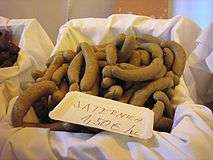Slovak cuisine
Slovak cuisine varies slightly from region to region across Slovakia. It was influenced by the traditional cuisine of its neighbours and it influenced them as well. The origins of traditional Slovak cuisine can be traced to times when the majority of the population lived self-sufficiently in villages, with very limited food imports and exports and with no modern means of food preservation or processing.
This gave rise to a cuisine heavily dependent on a number of staple foods that could stand the hot summers and cold winters. These included wheat, potatoes, milk and milk products, pork meat, sauerkraut and onion. To a lesser degree beef, poultry, lamb and goat, eggs, a few other local vegetables, fruit and wild mushrooms were traditionally eaten.
All these were usually produced and processed by families themselves with some local trade at the country markets. Wheat was ground, and bread, dumplings and noodles were made from it. Potatoes were mostly boiled or processed into potato dough. Milk was processed into a wide range of products such as butter, cream, sour cream, buttermilk, and various types of cheese etc.
Typical pork products include sausages, a local kind of blood sausages, smoked bacon, and lard. Spices were not widely used, and animal fats and butter were used instead of cooking oils. Main drinks included fresh and sour milk, and beer. Contemporary Slovak cuisine is widely influenced by various world cuisines and uses many different ingredients, spices and industrially processed foods.
Slovak dishes
- Halušky
- Bryndzové halušky (potato dumplings with bryndza - a sheep's-milk cheese)
- Strapačky
- Lokše (pancakes made of potato-dough baked directly on the stove)
- Bryndzové pirohy
- Široké rezance s tvarohom a slaninou: tagliatelle with quark (farmer's cheese) and fried bacon
- Zemiakové placky (potato pancakes fried in oil), also called Haruľa in regions Horehronie, Pohronie, Kysuce and Orava
- Granatiersky pochod or granadír, also known as granadírmarš and grenadírmarš
- Segedin goulash (a Hungarian dish consisting of pork stew with sauerkraut and cream or sour cream, usually served with steamed dumplings (knedľa).
- Rezeň (breaded schnitzel)
-
Chicken dish
-
Pork with milano sauce and yeast dumpling
-
Chicken dish with dumplings and cream sauce
Soups and sauces
- Fazuľová (soup made of beans)
- Kapustnica (soup made of sauerkraut)
- Rezancová (chicken soup with noodles)
- Demikát
- Tripe soup
Meat
Pork, beef and poultry are the main meats consumed in Slovakia, with pork being the most popular by a substantial margin. Among poultry, chicken is most common, although duck, goose, and turkey are also well established. A blood sausage called krvavničky, and sausage with rice called jaternice (traditionally called "hurky") also has a following, containing any and all parts of a butchered pig; it is an acquired taste. Game meats, especially boar, rabbit, and venison, are also widely available throughout the year. Lamb and goat are also available, but for the most part are not very popular. The consumption of horse meat is generally frowned upon.
Grilled meat is not common in Slovakia. Instead, meat is either breaded and fried in oil (schnitzel), or cooked and served in sauce. Hungarian influences in Slovak cuisine can be seen in popular stews and goulashes. However, these have been given Slovak touches. Chicken paprikash is typically served with halušky and Hungarian goulash (spicy beef stew) is served with slices of a large bread-like steamed dumpling.
-

jaternice
-

krvavnička
Traditional sweets and cookies
Usually baked at Christmas time, but also all year long, Slovak traditional sweets are usually home baked and harder to find in stores.
- Buchty (Buchteln)
- Parené buchty (steamed dumplings with various fillings (jam, plum, curd, poppy) topped with poppy seeds, sugar, butter, sourcream, breadcrumbs or nuts, similar to Austrian Germknödel, and Chinese Baozi buns)
- Laskonky (fluffy dough with walnuts and creamy filling)
- Žemľovka (bread pudding)
- Mačacie oči
- Ryžový nákyp (rice pudding)
- Orechovník, a sweet walnut roll]
- Makovník (poppy seed roll)
- Bratislavské rožteky
- Trotle (two layers of cookie-like round tarts filled with chocolate cream and half-dipped in dark chocolate)
- Medovníky
- Medvedie labky
- Trdelnik or Skalický trdelnik, a traditional cake baked on a rotating spit over open fire
Main daily meal
Traditionally the main meal of the day is lunch, eaten around noon. However, changing work routine has altered this in the recent decades; today, many Slovaks have their main meal in the evening. Lunch in Slovakia usually consists of soup and a main course. It is customary in Slovakia to bring a bottle of wine or other alcohol as a gift if you are invited to visit someone's home.
Books on Slovak cuisine
- Ján Babilon: Prvá kuchárska kniha, 1870
- Vojtech Španko a kolektív: Slovenská kuchárka, vydavat. Osveta, Martin, 1977, 4.vydanie 1982
- František Kotrba: Slovenská kuchařka, Dona, ISBN 80-7322-025-3
- Anna Demrovská: Dobrá slovenská kuchyňa, Knižné centrum, 2007, ISBN 80-85684-59-4
- Ľudmila Dullová: Veľká slovenská kuchárka, Ikar, 2007, ISBN 80-7118-783-6
- Jana Horecká: Najlepšia slovenská kuchyňa, 2007, ISBN 80-8064-300-8
- Daša Racková: Nová slovenská kuchárka, Ikar, 2007, ISBN 978-80-551-1563-4
- Zora Mintalová - Zubercová: Všetko okolo stola I., Vydavateľstvo Matice slovenskej, 2009, ISBN 978-80-89208-94-4
- Zora Mintalová - Zubercová: Všetko okolo stola II., Vydavateľstvo Matice slovenskej, 2010, ISBN 978-80-81150-13-5
See also
References
External links
- Bake Your Slovak Roots - contemporary, simple and everyday approach to classic slovak cooking
- Illustrated Slovak recipes
- Emperor's Crumbs - Central European food and recipe blog.
| |||||||||||||||||||||||||||||||||||||||||||||||||||
| ||||||||||||||
